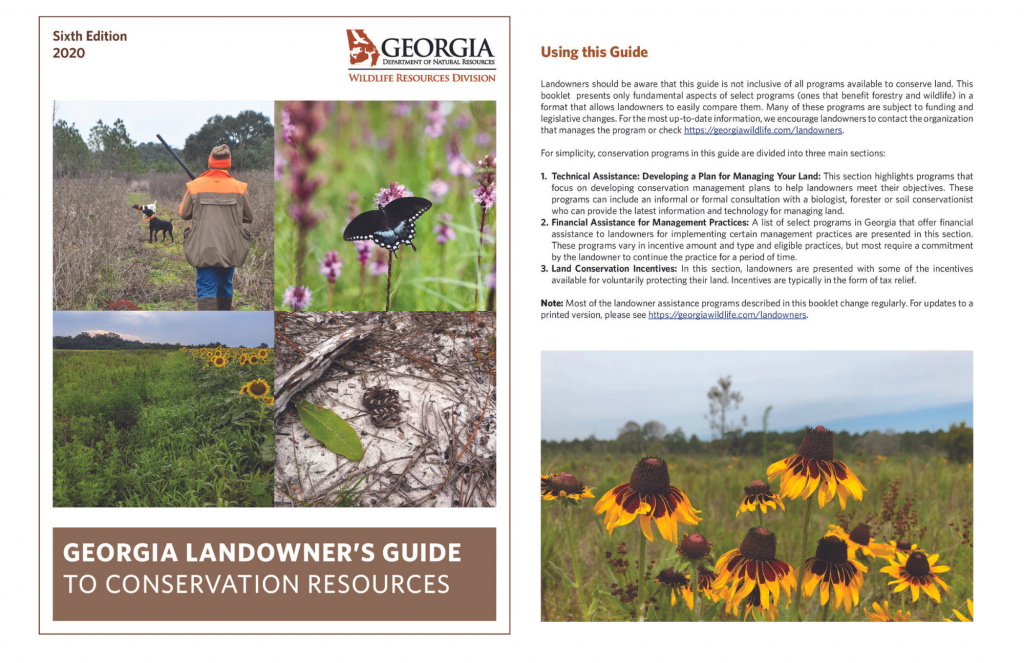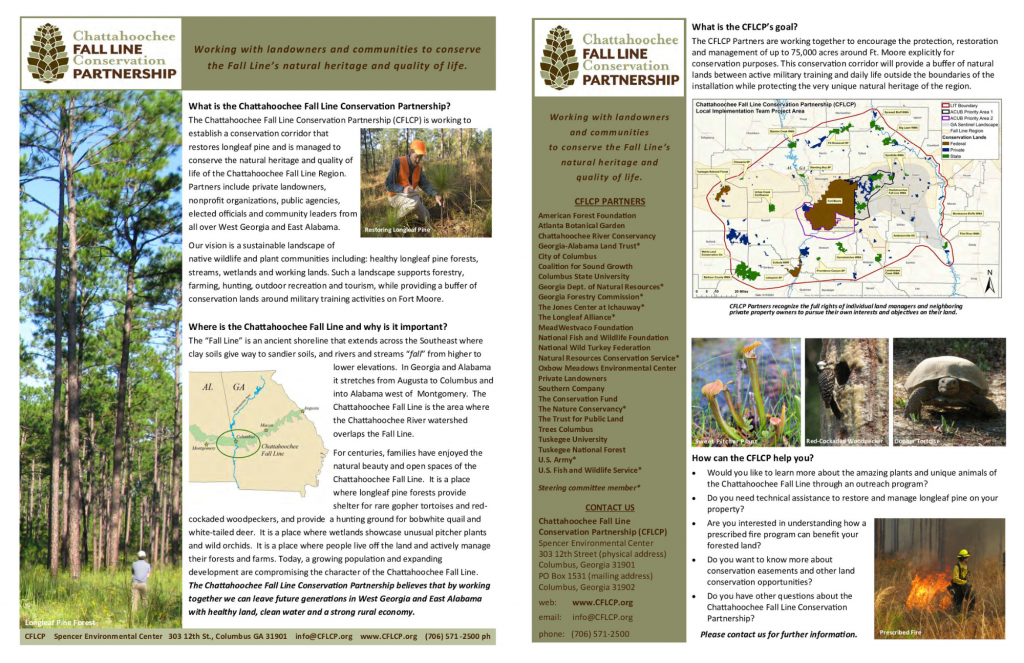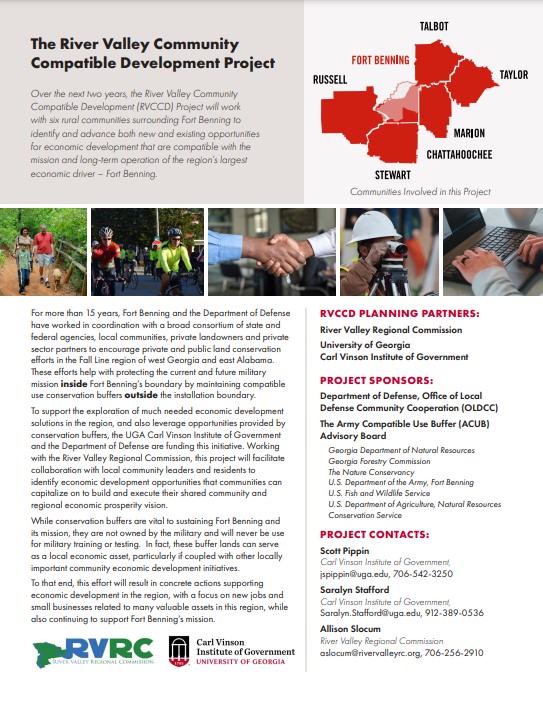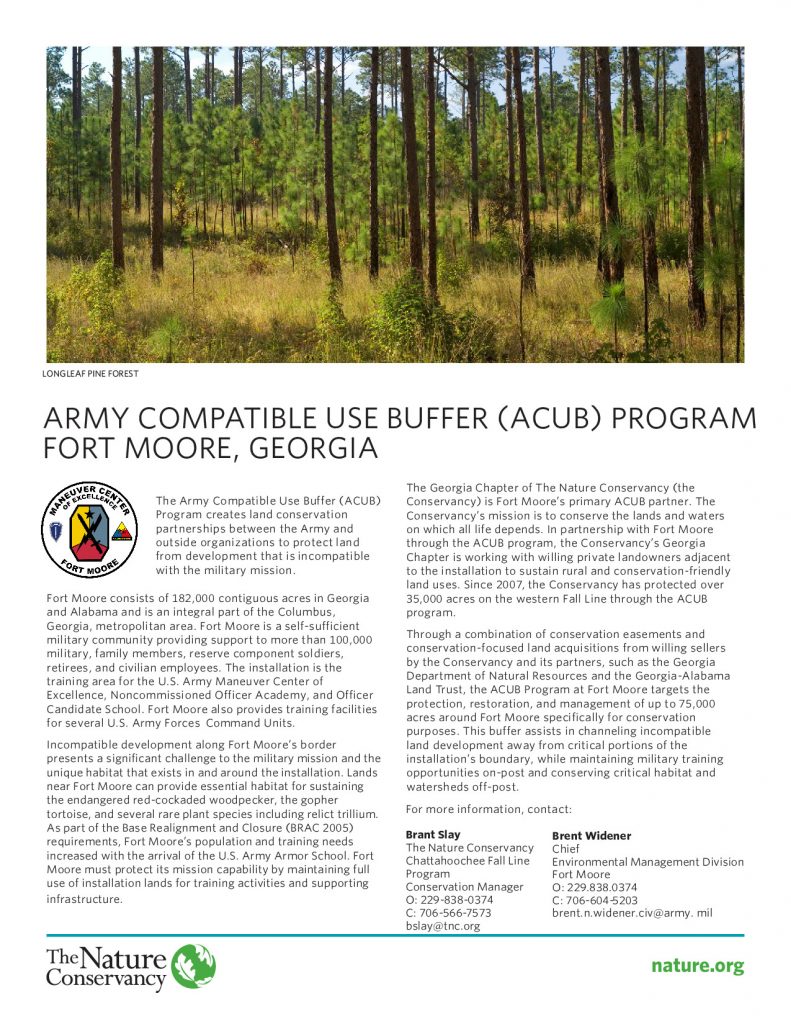To learn more, click below to jump to these areas of content:
General Longleaf Pine Information

Longleaf Pine (Pinus palustris)
The longleaf pine forest is a biologically diverse, fire-adapted, ecosystem that once dominated 90 million acres across the Southeast. Today, this ecosystem is much less common and only about 5.2 million acres remain across its historic range.
Many native plants and animals, including species of conservation concern, rely on habitat provided by the longleaf pine forest. Today, several plant and animal populations are in jeopardy because of the decline of the longleaf pine ecosystem.

The decline of the longleaf forest occurred over a long period of time and was due to several factors including:
- The harvest of mature longleaf trees without attention to replanting young longleaf trees and replanting former longleaf sites with other kinds of trees (most often loblolly or slash pine).
- Tapping longleaf trees for resin to produce ‘naval stores’ (turpentine/tar) caused tree mortality.
- Converting land from longleaf forest to agricultural use or intensive human use (i.e. “development”).
- The idea promoted by Smokey the Bear (and others) that proclaimed “all fire is bad for the forest.” Longleaf is a tree which depends on periodic fire in order to thrive.
Fortunately, both public and private conservation groups recognized the need to address the decline of this iconic forest ecosystem. Working together partners drafted the “Range-wide Conservation Plan for Longleaf Pine” in 2009. This collaborative effort enhanced the efficiency, leadership, and communication around longleaf pine and accelerated its restoration across the historic range.
Conservation partners created America’s Longleaf Restoration Initiative (ALRI) and set a goal to restore 8 million acres of longleaf by 2025. Their collaborative efforts have successfully reversed the century-long decline of longleaf pine across nine southern states! The National Fish and Wildlife Foundation (NFWF) strongly supports longleaf restoration and the goals of ALRI through the Longleaf Landscape Stewardship Program.
The Chattahoochee Fall Line Conservation Partnership (CFLCP) is working locally in west Georgia and east Alabama, where longleaf was historically abundant, to help achieve the range-wide restoration goal set by ALRI.
Private landowner participation in longleaf restoration is critical! Are you interested in learning more about longleaf pine and understanding if it fits your goals as a forest landowner? If so, there are many resources to assist you. Please refer to the Landowner Resources section of this website or contact the CFLCP for more information.
Prescribed Fire

Longleaf pine forests are adapted to fire. Prescribed burning in longleaf stands provides a variety of benefits including:
- Reduced competition from less desirable plants
- Enhanced control of forest pests & diseases
- Improved habitat for wildlife
- Reduced fuel build up
- Promotes native understory diversity
Many of the plants and animals living in the Chattahoochee Fall Line region are “fire dependent” and require regular burning in order to thrive. Historically, fire was common in the area and was often ignited naturally by lightning strikes. It was also intentionally set by Native Americans and settlers who understood the benefits of fire. But, in the last century emphasis has been on the suppression of all fire. In the absence of periodic burning, fire dependent species such as the longleaf pine along with animals like the gopher tortoise that live in the longleaf forest have declined. In addition, dangerous amounts of fuel have built up in many forested areas, increasing the risk of hard-to-control wildfires. Today, prescribed fires — carefully planned and implemented under precise conditions by trained individuals – are an important land management tool used to improve forest health and accomplish ecological restoration across the region.
If you are considering using prescribed fire on your land, there are resources available to help answer your questions about prescribed burning, opportunities to get burn training, and personnel to assist you with burning.
Please refer to the Landowner Resources section of this website for more information.
Frequently Asked Questions About Prescribed Fire
What does a prescribed fire look like?
Do I need a permit to burn?
Yes, prior to ignition, all prescribed burns require a burn permit.
Burn permits, also called burn authorizations, can be obtained from:
- Georgia Forestry Commission (GFC)
Contact your county GFC ranger. To do so, visit this link to find the contact information for your county’s GFC county office: https://gatrees.org/burn-permits-and-notifications/ - Alabama Forestry Commission
Call 1-800-392-5679 or for online Information, visit: https://forestry.alabama.gov/Pages/Fire/Burn_Permits.aspx
Certified Prescribed Burn Mangers can get permits online at: https://burnpermits.forestry.alabama.gov/Default.aspx?ReturnUrl=%2f
Can I hire someone to burn for me, or must I do it myself?
You may hire trained personnel to execute prescribed fire on your land. Your state’s Forestry Commission staff as well as independent contractors are available for hire to complete prescribed burning for you. Or, with proper training you can implement the burning yourself.
In west Georgia, The Chattahoochee Fall Line Rx Fire Co-Op offers a variety of helpful resources to private landowners interested in prescribed fire. https://gatrees.org/fire-prevention-suppression/cflrxfirecoop/
In Alabama, the Central Alabama Prescribed Burn Association (CAPBA) offers a variety of helpful resources for private landowners interested in prescribed fire. Find them on Facebook: https://www.facebook.com/Central-Alabama-Prescribed-Burn-Association-CAPBA-112900554514450/
What time of year do I need to burn, and how often?
The answer to these questions is specific to each property and the landowner’s objectives for the property. Prior to implementing a prescribed fire program, it is desirable for landowners to consult with a trained forestry or wildlife professional to develop a comprehensive management plan for their property, which would address these topics.
Resources and References
Want to learn more about longleaf pine? This information will help you get started.
| General Longleaf Pine Information | |
| America’s Longleaf Restoration Initiative | Americaslongleaf.org |
| Chattahoochee Fall Line Conservation Partnership | CFLCP Facebook Page |
| The Chattahoochee Fall Line Facebook Discussion Group | Facebook discussion group |
| The Jones Center at Ichauway | http://jonesctr.org/ |
| The Longleaf Alliance | Longleafalliance.org |
| The Forest That Fire Made: An Introduction to the Longleaf Pine Forest by John McGuire, Carol Denhof, and Byron Levan. 2023 | Book |
| Ecological Restoration and Management of Longleaf Pine Forests edited by L. Katherine Kirkman and Steve B. Jack. 2021. | Book |
| Longleaf, Far as the Eye Can See: A New Vision of North America’s Richest Forest by Bill Finch, Beth Maynor Young, Rhett Johnson & John Hall. 2012. | Book |
| Looking for Longleaf: The Fall and Rise of an American Forest by Lawrence S. Earley. 2006. | Book |
| The Art of Managing Longleaf: A Personal History of the Stoddard-Neel Approach by Leon Neel, Paul Sutter & Albert Way. 2011. | Book |
| The Nature Conservancy: Chattahoochee Fall Line | https://www.nature.org/en-us/get-involved/how-to-help/places-we-protect/chattahoochee-fall-line/ |
| Landowner Resources | |
| Georgia Alabama Land Trust | Conservation Easement Information Piedmont, Alabama Office (256) 447-1006 https://www.galandtrust.org/ |
| Georgia Department of Natural Resources | Private Lands Program https://georgiawildlife.com/privatelandsprogram https://georgiawildlife.com/landowners |
| Natural Resources Conservation Service (NRCS) | NRCS Technical and Financial Assistance https://www.nrcs.usda.gov/getting-assistance Find Your State Website & District Conservationist Alabama: https://www.nrcs.usda.gov/wps/portal/nrcs/site/al/home/ Georgia: https://www.nrcs.usda.gov/wps/portal/nrcs/site/ga/home/ |
| U.S. Fish & Wildlife Service’s Partners for Fish & Wildlife Program | Financial & Technical Assistance for Longleaf Restoration Activities Partners for Fish and Wildlife Program Alabama Contact: Rob Hurt, Rob_Hurt@fws.gov; tel: (256) 353-7243 ext. 29 Georgia Contact: Jim Bates, Jim_Bates@fws.gov; tel: (706) 544-6030 |
| West Central Georgia Forest Landowner Association | https://www.facebook.com/WCGFLA |
| Prescribed Fire | |
| Alabama Department of Conservation & Natural Resources | https://www.outdooralabama.com/wildlife-management-programs/prescribed-fire-alabama |
| Alabama Forestry Commission | Burn Permits, Certification Training & Prescribed Burning |
| Alabama Prescribed Fire Council | http://alpfc.org/ |
| Central Alabama Prescribed Burn Association (CAPBA) | https://www.facebook.com/Central-Alabama-Prescribed-Burn-Association-CAPBA-112900554514450 |
| Chattahoochee Fall Line Prescribed Fire Co-Op | https://gatrees.org/fire-prevention-suppression/cflrxfirecoop/ |
| Georgia Department of Natural Resources | https://georgiawildlife.com/sites/default/files/wrd/pdf/quail/4-BQI%20Prescribed%20Burning.pdf |
| Georgia Forestry Commission | Burn Permits, Certification Training & Prescribed Burning |
| Georgia Prescribed Fire Council | http://www.garxfire.com/ |
| Southern Fire Exchange | https://southernfireexchange.org/ |
| Guidebook for Prescribed Burning in the Southern Region, UGA Cooperative Extension Bulletin 1560 | WSFNR-23-16A. 2023 Book PDF Download Available: | https://extension.uga.edu/publications/detail.html?number=B1560 |
| Wildlife and Longleaf Pine | |
| Alabama Department of Conservation & Natural Resources | Red-cockaded Woodpecker Gopher Tortoise |
| Georgia Department of Natural Resources | Red-cockaded Woodpecker Gopher Tortoise |
| Gopher Tortoise Conservation Initiative | https://georgiawildlife.com/georgia-initiative-played-role-tortoise-listing-decision |
| Gopher Tortoise Council | https://gophertortoisecouncil.org/ |
| National Bobwhite Conservation Initiative | http://bringbackbobwhites.org/ |
| National Wild Turkey Federation | Alabama Chapter Georgia Chapter |
| Quail Forever | https://quailforever.org/ |
| U.S. Fish & Wildlife Service | Red-cockaded Woodpecker Gopher Tortoise |
| Information for Teachers and Students | |
| Burner Bob | https://longleafalliance.org/wp-content/uploads/2021/01/Burner-Bob-and-Friends.pdf |
| Ecosystem Poster | https://longleafalliance.org/merchandise/ |
| Learning with Longleaf Curriculum | https://longleafalliance.org/wp-content/uploads/2021/04/Learning-with-Longleaf-2021-reduced.pdf |
| Sandhill's Teacher Guide | https://georgiawildlife.com/SandhillsTeacherGuide |
Publications Available for Download

Click here to download “Georgia Landowner’s Guide To Conservation Resources” (Sixth Edition, 2020).

Click here to download the “Chattahoochee Fall Line Conservation Partnership” Program Overview

Click here to download the “River Valley Compatible Community Development Project” Overview

Click here to download information on the “Army Compatible Use Buffer (ACUB) Program” at Fort Moore
